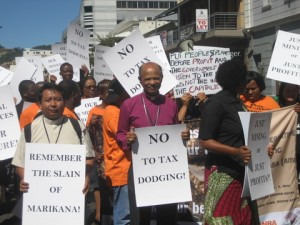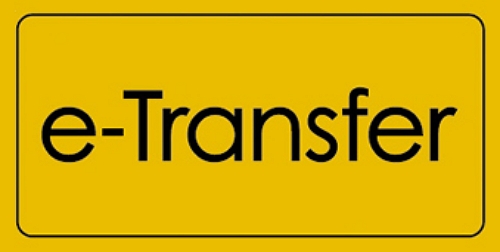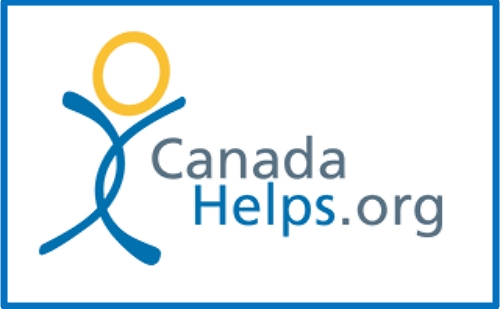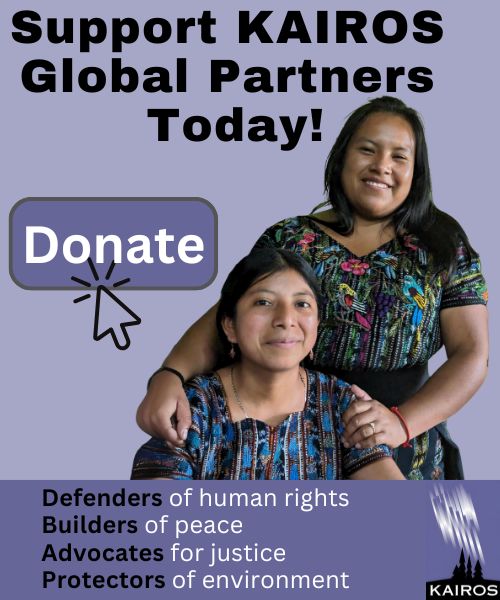Alternative Mining Indaba 2013
Ian Thomson, KAIROS Program Coordinator for Ecological Justice through Corporate Accountability, represented KAIROS at the Alternative Mining Indaba, held February 3-5 in Cape Town, South Africa. Here, he shares his reflections and news from the Indaba (Zulu for ‘meeting’), including a report on the ongoing impact of the August 2012 police attack on striking mine workers in Marikana.
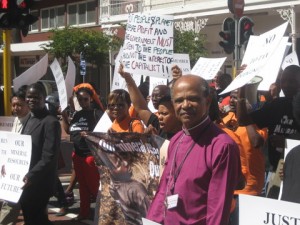 How did I know I was attending a church-organized conference in southern Africa? I had a strong clue within the first hour when the conference proceedings stopped several times to break into joyous song, spontaneously and totally unscripted. It was energizing and inviting, a gathering where people were just as apt to call each other “comrades” as fellow participants.
How did I know I was attending a church-organized conference in southern Africa? I had a strong clue within the first hour when the conference proceedings stopped several times to break into joyous song, spontaneously and totally unscripted. It was energizing and inviting, a gathering where people were just as apt to call each other “comrades” as fellow participants.
The 4th Alternative Mining Indaba, held on February 3-5 in Cape Town, South Africa, brought together over 100 mining activists from throughout southern Africa. I had the opportunity to represent KAIROS at the gathering. Canada is very active in the African mining sector, with over $23 billion invested by Canadian-based companies in 2010. As a result, several African church representatives and other civil society organizations were interested in what role Canadian churches might play in supporting their local struggles for mining justice.
Rev. Malcolm Damon of the Economic Justice Network (EJN) gave a powerful opening address that explored the issue of how we share resources. He referred to the Freedom Charter to help situate the justice issues around natural resources. Drafted in 1955 by the anti-apartheid movement to express its vision for a free and just South Africa, the Freedom Charter envisions the country’s rich natural resources as something that will benefit all citizens. While the apartheid system was torn down almost 20 years ago, the economic vision of the Freedom Charter is still far from being realized. That is the challenge that the South African churches must speak out on prophetically, that the economic justice transformation of society is far from achieved.
Who does the new South Africa belong to?
What struck me the most from my conversations at the indaba was the generational shift that is happening right now in South African social movements. The country seems to be at an inter-generational turning point. An older generation of organizers and activists, who led and won the struggle against apartheid, have assumed prominent roles in government, trade unions and mining companies. While they have successfully established a multi-racial democracy in South Africa, they are also becoming comfortable in their institutional roles. Today a younger generation of workers and activists, who understand the achievement of anti-apartheid heroes but did not live through the struggle themselves, is challenging the economic disparities that persist. They are not afraid to challenge the African National Congress when it seems to be acting as an elite club and not a progressive movement for social change. For many in the older generation, the ANC is still perceived as the freedom fighter and liberator. For the younger generation, the ANC represents entrenched power and resistance to more radical social change. How this dynamic plays out over the next few years is anyone’s guess. But it’s not going away and will only get more pronounced as economic inequality widens and youth unemployment continues to rise.
Marikana: A turning point
One of the most shocking and tragic events to illustrate the economic disparities of modern South Africa is the Marikana tragedy of last August. Striking mine workers in Marikana were peacefully demonstrating when police opened fire on them, killing 34 workers and seriously injuring dozens more. The nation was shocked; the international media reported the story around the world. It was the largest killing of civilians at the hands of police in South Africa since the end of apartheid in 1994.
The opening panel at the Alternative Indaba included three people from Marikana who told us their firsthand accounts of that day and what impact it has had on their community since. The first panelist spoke of the despair that people are feeling. A few survivors of the violence have committed suicide, something that was relatively uncommon in the community until now. As he put it, the Marikana tragedy is still killing their people. More slowly, more quietly, but killing them all the same.
The mine workers at Marikana were organizing for better working conditions, including a living wage of 12,500 Rand per month. The workers wanted to sit down with their employer to negotiate, but the company refused. Many believe the whole tragedy could have been averted if the company had acted responsibly and engaged the workers in good faith.
A representative from the Marikana workers’ committee spoke about how workers were losing faith in the National Union of Mineworkers (NUM). The union is closely allied with the government, which itself has various links to the major mining conglomerates. Some senior government officials and their close relatives are big shareholders in mining companies and sometimes even sit on their boards of directors, which leaves workers doubting whether the union is always standing up for workers’ interests or being swaying by powerful political friends. Some allege that the police action at Marikana may have resulted from orders from someone high up in the company who used their government connections to order the police to clear away the workers. A Marikana commission of inquiry is currently underway to investigate and get to the bottom of the events of that day.
The third panelist was a woman from the community who explained how the widows and other family members are not receiving the care and counselling they need. For some, paying the bus fare to seek counselling is too great a barrier for them. She made an appeal to the Alternative Indaba participants to donate to support these families, whatever they could offer, and a collection was taken up.
Hassen Logart of the Bench Marks Foundation of South Africa spoke about how Marikana has opened up political space to debate the impacts of mining on workers and communities, and the economic disparities that persist despite the country’s huge mineral wealth.
The Bench Marks Foundation runs an excellent program called the Community Monitors training school. For the past few years, the program has trained members of mining affected communities to track, report on and organize around local mining impacts. More information about the program is available on the Community Monitors website: http://communitymonitors.net/
In 2011, the Marikana community monitors released their preliminary report on the poor wages, social living conditions and other problems they faced. The Bench Marks Foundation launched a more comprehensive report about the conditions at Marikana on August 15, 2012, the day before the massacre. There was little media interest in these reports; the concerns and recommendations went largely ignored. All of that changed on August 16, when journalists from South Africa and throughout the world were knocking down the door of the Bench Marks Foundation to learn about what had caused the tragic events and help put them into context.
Logart pointed out that when the African National Congress discussed its mining policy at its policy conference in June 2012, the policy was left largely the same. That was two months before the events at Marikana. Since the massacre, politicians have had no choice but to grapple with the issues it raises. Why, asked Logart, do people need to get killed before our political leaders will start to discuss economic injustice seriously?
The challenge for the Alternative Indaba is not to allow those workers’ death to be in vain. If indeed there is a new debate sparked in South African society, how can it lead to more equitable sharing of wealth, better conditions for workers and their families, and better protections for the environment in the face of massive mining operations?
Thinking Radically
Day Two of the Alternative Indaba was opened by Bishop Jo Seoka of Pretoria and Rev. Suzanne Matale of Zambia, both of whom KAIROS had hosted at the Ecumenical Conference on Mining in Toronto in May 2011.
Bishop Seoka has emerged as a key figure in the Marikana struggle, acting as a respected mediator between the workers, the government and the police. He urged participants at the Alternative Indaba to “think radically if we are to act radically,” and move beyond business as usual. We must hold indabas with more mining affected people so we can hear directly what they expect from the resources on their lands. He said he is tired of hearing companies talk about “corporate social responsibility” and “community social investment”. Why can’t they just hire local workers and pay them a living wage?, he asked. Wouldn’t this be much simpler? Instead, the companies bring in migrant workers from far away and pay them poverty wages, which leads to social tensions and a lack of community development. This model must be changed if mining is to benefit the people.
Bishop Seoka urged the indaba participants to stand in solidarity with communities, not to speak for them. We must strengthen and amplify their voices.
After the Bishop’s remarks, Dr. Kojo Busia of the UN Economic Commission on Africa (UNECA) delivered a keynote address about the African Mining Vision. Adopted by African heads of state in 2009, the African Mining Vision lays out a new paradigm for mineral development on the continent.
For Canadians unfamiliar with the Vision, I’d invite you to read a very helpful briefing note on the African Mining Vision and Canada’s role that was released by the Africa-Canada Forum of CCIC in January 2013. It is available on the CCIC website: http://www.ccic.ca/_files/en/working_groups/2013-04-02-AMV_backgrounder_EN.pdf
Civil society groups I spoke to at the Alternative Indaba held a variety of different views about the African Mining Vision. Some felt that it was a major achievement in itself for African governments to map out and collectively agree on a new vision for mineral development on the continent. Others felt that the Vision is full of nice words but will amount to little else, fearing that governments cannot muster the political will to pursue and implement it. Others felt the Vision would be implemented but only very selectively, with most emphasis put on collecting more revenue for central government coffers. More groundbreaking elements of the Vision, such as those dealing with artisanal mining and local economic development opportunities, would be left languishing. Despite these divergent viewpoints, most people I spoke to agreed that the Vision presents yet another avenue for communities and civil society organizations to press governments, including foreign governments like Canada, and companies to ensure mining in Africa provides real benefits to local communities.
Bringing our Message to the Streets
After two days of learning and deliberating, Alternative Indaba participants drew up a final declaration to summarize our major concerns and demands. The final statement calls for a unified and coordinated social movement to struggle for mining justice in Africa, and includes several recommendations to African governments around community development, human rights, taxation, and alternatives to mining. The final declaration is available on the Economic Justice Network website: http://www.ejn.org.za/wp-content/uploads/images/stories/Peoples_Indaba_Final_Declaration.pdf
On the last day of the Alternative Indaba, we all marched in the streets to deliver the declaration to the corporate mining indaba that was being held across town at the International Convention Centre.
The corporate mining indaba is an annual investor conference that attracts more than 7,000 delegates from companies and governments who get together to make deals and promote corporate mining. Canadian mining promoter Robert Friedland was among the keynote speakers this year. Canadian companies and the Canadian government are both well represented.
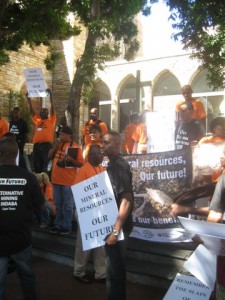 As we gathered for our march on the steps of St. George`s Cathedral, I was struck by the history of the place where so many anti-apartheid marches and protests had set forth. It is the home church of Archbishop Desmond Tutu and countless other anti-apartheid activists over the years.
As we gathered for our march on the steps of St. George`s Cathedral, I was struck by the history of the place where so many anti-apartheid marches and protests had set forth. It is the home church of Archbishop Desmond Tutu and countless other anti-apartheid activists over the years.
When we arrived outside the convention centre, we were stopped by police and security guards. Bishop Seoka went to them and explained that we had come to deliver a declaration to the South African mines minister inside and would not be leaving until she received it. Chanting and singing and dancing, we blocked the flow of cars and investors in and out of the convention. Finally, Bishop Seoka walked through the line of police and right up to the convention doors to deliver our message. “Go Bishop! Go Bishop!” chanted the crowd in support. He emerged five minutes later to read out the declaration over a loud speaker, and then present it to a messenger who brought it inside. The protest march was covered in several newspapers and radio shows, which helped the message reach an even wider audience. The conference closed with action planning for each country or region represented at the conference.
The Alternative Indaba was an impressive gathering of people, all concerned about mining and deeply committed to social justice. As I met church leaders, NGO representatives and community activists from over a dozen African countries (Angola, Botswana, Democratic Republic of Congo, Ghana, Kenya, Malawi, Mauritius, Mozambique, Namibia, South Africa, Tanzania, Zambia and Zimbabwe), I was struck by some of the commonalities between their different national struggles and also by the unique characteristics of each one. The Alternative Mining Indaba, together with the African Initiative on Mining Environment and Society (AIMES) network that KAIROS also supports, are key civil society spaces where new ideas are incubated, common strategies are hatched and our movements are strengthened. As a Canadian taking part, I was always on the lookout for new ways to offer solidarity, deepen existing partnerships and see things from a new perspective.
To learn more about KAIROS and our mining justice work, watch the new video, Remember the Land: Global Ecumenical Voices on Mining, and download the accompanying study guide.
